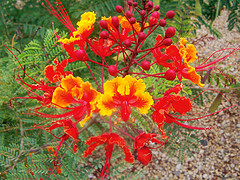It isn’t just agricultural biodiversity that needs looking after; sometimes it is the agriculture itself. In my in-basket today two stories of farms saved for the future. Coincidence, I’m sure, but it is not hard to glean a single message of nostalgia combined with urban alienation from the rescue of College Farm in north London and Gellatly Nut Farm in British Columbia. I’ve often thought that we should make more of the commonalities between developed and developing countries than we do. Maybe these stories will help.
Extra stimulation
The People vs Starbucks rumbles on. Fair Trade weighs in to the debate with an almost entirely decaffeinated post. A shame, really, as there are important issues to discuss in the realms of protecting farmer varieties in a fair and equitable manner. A new blog — Coffee Politics — devoted entirely to the subject, may be worth keeping an eye on.
Perennial wheat on trial
Researchers in Texas have planted a trial of so-called perennial wheat, which lasts about five years. Normal wheat flowers and dies in less than a year. The wheat, they say, is being evaluated particularly in the context of dual purpose grain and grazing use. Many farmers in the US west sow wheat and allow cattle to graze the young growth. After a while the cattle are removed and the wheat allowed to mature and flower. The perennial wheats, which have emerged from crosses of wheat with wild wheat grass (Agropyron spp) made in search of insect resistance and drought tolerance, would reduce the costs of seed and annual sowing.
Fine and dandy, but sad to see no mention whatsoever of the pioneering work by Wes Jackson and the Land Institute on the whole subject of perennial polyculture. Sad, but not entirely surprising; the Land Institute’s web site is by no means the easiest to find one’s way around. I visited a few years ago, and have kept up with their slow but steady progress towards “growing our own granola” but the truth is that despite Jackson’s wonderful oratory, not enough people know what they are doing there to promote edible biodiversity for the prairies. Try here for their latest publication on perennial polyculture.
Mysteries of medicinal plants remain
 A fascinating reflection by Dr S. Allen Coulter, professor of neurology and neurophysiology at Harvard Medical School and Massachusetts General Hospital, asks a question that perplexes many people: how did people acquire their detailed knowledge of the effects of plants on the body? Coulter’s musings are prompted by “scientific” studies on Caesalpinia pulcherrima, which reveal active ingredients that match the effects he was told by a wise person some years ago. I feel the same way about complicated food processing methods; how on earth did people learn how to render toxic and inedible things safe and delicious? Like Coulter, I fear we will never really know.
A fascinating reflection by Dr S. Allen Coulter, professor of neurology and neurophysiology at Harvard Medical School and Massachusetts General Hospital, asks a question that perplexes many people: how did people acquire their detailed knowledge of the effects of plants on the body? Coulter’s musings are prompted by “scientific” studies on Caesalpinia pulcherrima, which reveal active ingredients that match the effects he was told by a wise person some years ago. I feel the same way about complicated food processing methods; how on earth did people learn how to render toxic and inedible things safe and delicious? Like Coulter, I fear we will never really know.
Flickr photograph by Esther17 used under a Creative Commons License.
Housekeeping
Tidying up a bit round here.
- Links are now sub-divided into Individuals and Organisations; makes sense to us. Let us know about others you think we should include.
- There’s a category called Articles, with a page of its own, for longer pieces that we intend to provoke thought. Respond, if you like.
- Speaking of which, you no longer have to register to comment, although it would still be nice if you did. We think our anti-spam defences are reasonably secure, although we’ll be keeping an eye out for unwarranted penetration.
That’s it. Have a good week.